“Show Us Your Shorts” Film Festival
Location: UC 310
Free popcorn will be served during the screenings.
Moderator: Professor Corrie Parks
Strata: Layers in Space and Time
2:30 – 2:45 p.m.
Emma Ayala
Corrie Parks, Visual Arts
“Strata” is a synonym for layers, and Strata Animation is an animation technique where cells are successively placed so that many frames are visible at once. Strata animation is relatively new; it was first explored by animator Javan Ivey in 2007. I have experimented with this technique since I took ART488, the Handcrafted Animation special topics class, two years ago. Initially, a 9 second animation took 25 hours to complete—since then, I have built multiple rigs, learned to use a laser cutter, and developed multiple registration techniques in order to expedite the process. Additionally, I have employed variable and expressive lighting to add color to my animation, which is a new development for the medium of. I intend to show a rough cut of my senior project film, Monsterance, in which my exploration of handdrawn animation, animated objects, and strata animation are culminated.
This work was funded, in part, through an Undergraduate Research Award from the Division of Undergraduate Academic Affairs.
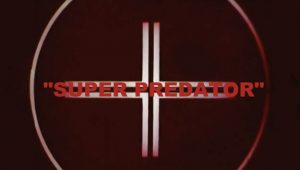
Super Predator
2:45 – 3 p.m.
Mehki Adams
Maleda Belilgne, English
“Super Predator” is a video art piece that reflects on the ways in which the media negatively depicts black identity and how that negative depiction is used to validate the social, legal, and physical mistreatment of black bodies. To create this piece, I compiled different images depicting negative black stereotypes and the physical mistreatment of black people. These clips, which range in historical time periods, constantly switch back and forth to resemble someone switching the channels on a television and to mimic the way stereotypes are typically spread. I show how these stereotypes and racist depictions have been nuanced throughout the years: ranging from images of docile slaves to super predators. The purpose of this piece is to bring attention to the circulation of negative stereotypes in the media and to display how racist narratives are used to justify unequal and brutal treatment of black people. The piece also illustrates the ubiquity of certain stereotypes, the context in which they are deployed, and through repetition forces viewers to confront their biases and assumptions.
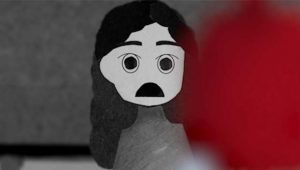
Photograph by Courtney Culp.
Color of Me
3 – 3:15 p.m.
Courtney Culp
Corrie Parks, Visual Arts
Color of Me is an abstract animated short, representing how I felt about my cultural identity as a child and how I embraced it as I grew up. In the story, a young girl notices the color of people around her and her lack thereof, so she embarks on a mission to obtain a color for herself. Only after several failed attempts does she realize that there are many people like her without color and is happy to belong. The film was done using both traditional stop motion techniques and computer animation. I hand crafted and cut out every aspect of the film. I shot the majority of the footage at the stop motion station, filming with a green screen background to allow myself more manipulation when editing in PremierePro. I also used a program called Character Animate, which allowed me to build/rig a “puppet” in Photoshop. Character Animate also provided additional controls where I could change my facial expressions through my laptop camera for more fluid movement in the facial expressions of my character. This film allowed me to share a personal part of my life while also allowing the audience to make connections to their own lives as well.
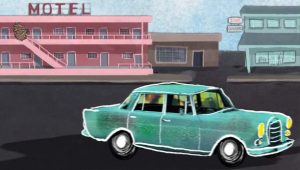
The Poetry of Jordann Allen: An Animated Documentary
3:15 – 3:30 p.m.
Ezra Pailer
Mentor: Corrie Parks, Visual Arts/p>
Baltimore and D.C. are home to remarkable communities of writers and artists who use poetry as a powerful tool to explore personal inner narratives. I’ve collaborated with D.C. area poet Jordann Allen to create an animated documentary that presents a selection of her writings and reveals how an artist’s intimate realms of imagery can be expressed across both visual and spoken mediums. The film provides a vivid glimpse into the worlds of Allen’s personal symbolism by combining hand-drawn animation with live-action film. Guided by the imagery in Allen’s poems, each scene was crafted in Adobe After Effects from an assortment of hand-illustrated Photoshop animations, digitally manipulated found images, and collections of live-action footage that were gathered in places ranging from local farms to friends’ gardens to coastal landscapes. The audio of Allen reading her poetry has a serene and fluid quality; this presented an interesting challenge in designing animated sequences that complement the flowing nature of a medium like poetry. The vision for this documentary is that it will invite viewers into the intricate worlds of imagery within Allen’s work as well as exhibit ways written or spoken art forms can be translated into motion. Allen will be joining me at URCAD in the presentation of the film.
This work was funded, in part, through an Undergraduate Research Award from the Division of Undergraduate Academic Affairs.
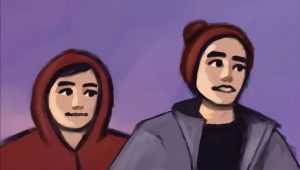
Image courtesy of Luke Ferguson
The Longfellow Hill
3:30 – 3:45 p.m.
Luke Ferguson
Corrie Parks, Visual Arts
In this 49 second self-portrait animation two siblings go sledding at their neighborhood hill and a sequence of funny gags ensue. As they slowly carve a path down the hill a series of mishaps hinder their progress. Will they even make it to the bottom? I chose the activity of sledding due to its potential as an encouragement for perseverance as each time you go down you carve out more of a path allowing you to go further the next time. Even the runs that seem to end in disaster impart experience needed to make a stronger future attempt. Created in the raster based software Krita, The Longfellow Hill utilizes a digital painting style approach in its animation. This method was chosen for its unique visual look after being previously used in a rotoscoping assignment. Sound design, which drew from stock sound libraries, is primarily diegetic in nature emphasizing the actions taking place and helping to build the atmosphere of the short.
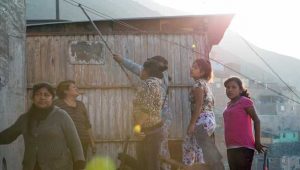
Freely You Have Received, Freely Give: A Documentary of Catholic Missions in Peru
3:45 – 4 p.m.
Rachel Morin
Sarah Sharp, Visual Arts
Christian missionaries travel to impoverished areas where they build and paint houses, move rocks, and give snacks to hungry children – but what is the ultimate purpose of this service work? What drives people to leave their comfortable homes to endure cold showers and less than six hours of sleep in a place where they are seen as foreigners? Are these young people really making a difference? This film explores the missions of a Catholic University in Lima, Peru, which has orchestrated service work in the poorest areas of the city for over seventeen years. From June to early August of 2017, I traveled to the site of these missions with my bulky DSLR camera to interview student missionaries, their mentors, and the people they served. What I found was that while the material wealth and manual labor were a welcome help, the most distinguishing aspect of these missions was the lasting partnership formed between communities in need and the university students.
This work was funded, in part, through the Linehan Artist Scholar Summer Study Award, and was a recipient of the Undergraduate Research Award from the Division of Undergraduate Academic Affairs.